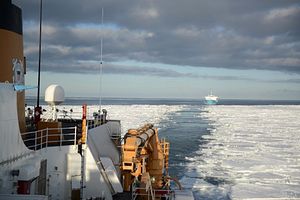In its attempt to accelerate the construction of additional polar icebreakers, the U.S. Coast Guard awarded five firm fixed-price contracts for heavy polar icebreaker design studies and analysis on February 22, the service reports in a press release. The combined value of the contracts is approximately $20 million.
“The objective of the studies are to identify design and systems approaches to reduce acquisition cost and production timelines,” the press release notes. “In addition to a requirement to develop heavy polar icebreaker designs with expected cost and schedule figures, the contracts require: the awardees to examine major design cost drivers; approaches to address potential acquisition, technology, and production risks; and benefits associated with different types of production contract types.”
The studies are slated to be completed within the next 12 months after the U.S. Coast Guard intends to release an initial draft request for proposals (RFP), followed by a final RFP in the last quarter of 2018. A final contract is estimated to be awarded in 2019 with the construction phase tentatively scheduled for the last quarter of 2019 to the end of 2020.
“These contracts will provide invaluable data and insight as we seek to meet schedule and affordability objectives,” said Rear Admiral Michael Haycock, the Coast Guard’s Director of Acquisition Programs and Program Executive Officer. “Our nation has an urgent need for heavy polar icebreaking capability. We formed an integrated program office with the Navy to take advantage of their shipbuilding experience. This puts us in the best possible position to succeed in this important endeavor,” he added.
As I reported elsewhere (See: “Russia and China in the Arctic: Is the US Facing an Icebreaker Gap?”):
[T]he United States currently operates two polar icebreakers: the Polar Star and the Healy. However, only the Polar Star is a heavy icebreaker capable of accessing all of the Arctic year-round. (The Polar Star’s sister ship, the Polar Sea, had a major engine breakdown in 2010 and has not been operational ever since.) Furthermore, the Polar Star, commissioned in 1976, is slated to reach the end of its operational lifespan in 2020.
However, Haycock’s endeavor to accelerate the construction process will face a number of fiscal and institutional constraints:
First, it would need to find a way to circumvent the standard acquisition approach that would take the Coast Guard about ten years to build a new ship. (…) Second, the U.S. Coast Guard is facing severe budgetary constraints. The money ($1 billion) it would need to kick-start the development and construction of a new icebreaker is equivalent to the entire acquisitions budget of the Coast Guard for 2015.
The U.S. Coast Guard did not see a substantial increase in its 2016 icebreaker acquisition budget and it is unclear whether the additional funds will be allocated in this year’s budget.
Meanwhile, U.S. competitors in the Arctic have been expanding their presence in the region. In December 2015, the Chinese People’s Liberation Army Navy commissioned the lead ship of a new class of icebreakers, the Type 272 Hai Bing 722, into its Northern Fleet. In March 2016, the PLAN commissioned its sister ship, the Hai Bing 723. Furthermore in December 2016, China started construction of its first domestically-built icebreaking research vessel. Russia currently operates 40 icebreakers and intends to commission over a dozen additional vessels in the coming years. Out of the 40, around 27 are ocean-going icebreakers, four of which are nuclear-powered. Moscow also intends to commission the world’s largest nuclear icebreaker in 2019, according to media reports.

































